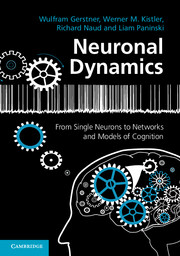Book contents
- Frontmatter
- Contents
- Preface
- PART ONE FOUNDATIONS OF NEURONAL DYNAMICS
- PART TWO GENERALIZED INTEGRATE-AND-FIRE NEURONS
- 5 Nonlinear integrate-and-fire models
- 6 Adaptation and firing patterns
- 7 Variability of spike trains and neural codes
- 8 Noisy input models: barrage of spike arrivals
- 9 Noisy output: escape rate and soft threshold
- 10 Estimating parameters of probabilistic neuron models
- 11 Encoding and decoding with stochastic neuron models
- PART THREE NETWORKS OF NEURONS AND POPULATION ACTIVITY
- PART FOUR DYNAMICS OF COGNITION
- References
- Index
8 - Noisy input models: barrage of spike arrivals
Published online by Cambridge University Press: 05 August 2014
- Frontmatter
- Contents
- Preface
- PART ONE FOUNDATIONS OF NEURONAL DYNAMICS
- PART TWO GENERALIZED INTEGRATE-AND-FIRE NEURONS
- 5 Nonlinear integrate-and-fire models
- 6 Adaptation and firing patterns
- 7 Variability of spike trains and neural codes
- 8 Noisy input models: barrage of spike arrivals
- 9 Noisy output: escape rate and soft threshold
- 10 Estimating parameters of probabilistic neuron models
- 11 Encoding and decoding with stochastic neuron models
- PART THREE NETWORKS OF NEURONS AND POPULATION ACTIVITY
- PART FOUR DYNAMICS OF COGNITION
- References
- Index
Summary
Neurons in the brain receive input from thousands of other, presynaptic neurons, which emit action potentials and send their spikes to their postsynaptic targets. From the perspective of a postsynaptic neuron receiving a barrage of spikes, spike arrival times may look completely random, even under the assumption that presynaptic neurons generate their spikes by a deterministic process. Indeed, as we have seen in the preceding chapter, internal noise sources of a cell, such as spontaneous opening of ion channels, do not account for all the variability of spike-trains encountered in freely behaving animals in vivo. Rather, it is likely that a large fraction of the apparent variability is generated by the network. Modeling studies confirm that networks with fixed random connectivity can lead to chaos on the microscopic level, so that spike arrival times appear to be random even if generated by a deterministic network.
In this chapter, we discuss the consequences of stochastic spike arrivals for modeling. The “noise” generated by the network is often described by a noise term in the differential equation of the membrane voltage (Section 8.1). Such a noise term, typically modeled as white noise or colored noise, can be derived in a framework of stochastic spike arrival, as shown in Section 8.2. Stochastic spike arrival leads to fluctuations of the membrane potential which will be discussed in the case of a passive membrane (Section 8.2.1) – or, more generally, for neuron models in the subthreshold regime.
- Type
- Chapter
- Information
- Neuronal DynamicsFrom Single Neurons to Networks and Models of Cognition, pp. 202 - 223Publisher: Cambridge University PressPrint publication year: 2014



